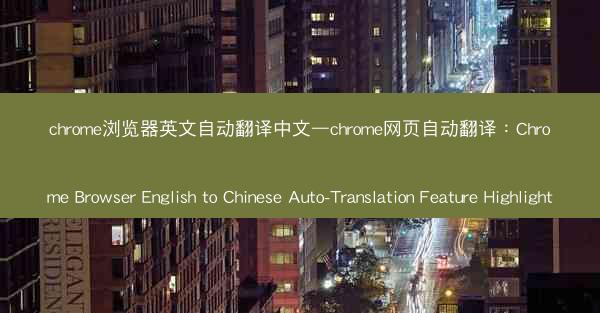纸飞机TG
纸飞机TG
-

Introduction to Chrome Browser English to Chinese Auto-Translation Feature
The Chrome browser, developed by Google, is one of the most popular web browsers worldwide. One of its standout features is the built-in auto-translation tool, which allows users to easily translate English text to Chinese and vice versa. This article will highlight the key aspects of this auto-translation feature, making it easier for users to navigate and understand English content on the web.
How to Enable Auto-Translation in Chrome
To enable the auto-translation feature in Chrome, follow these simple steps:
1. Open Chrome and go to the settings by clicking on the three dots in the upper right corner.
2. Select Settings from the dropdown menu.
3. Scroll down and click on Advanced.\
4. Under the Language section, click on Language.\
5. Click on the Add languages button and select Chinese (Simplified) or Chinese (Traditional) depending on your preference.
6. Once added, Chrome will automatically translate web pages in English to Chinese.
Understanding the Translation Options
Chrome offers various translation options that users can customize according to their needs:
1. Automatic Translation: Chrome automatically translates web pages in English to Chinese when you visit them.
2. Right-click Translation: Users can right-click on any English text and select Translate to Chinese to get an instant translation.
3. Translate All Pages: Users can enable this option to translate all web pages they visit, regardless of the language.
Accuracy and Quality of Translations
The auto-translation feature in Chrome utilizes Google Translate, which is known for its high accuracy and quality. However, it's important to note that no translation tool can perfectly replicate the nuances of human language. Users should still review translations to ensure they are accurate and make sense in context.
Customizing Translation Settings
Users can further customize the translation settings in Chrome to enhance their experience:
1. Translation Quality: Users can choose between Default, Fluent, and Formal translation quality settings.
2. Translation Memory: Chrome can save your translations and use them for future translations, improving the accuracy over time.
3. Dictionary: Users can access a dictionary within Chrome to look up words and phrases.
Limitations of the Auto-Translation Feature
While the auto-translation feature in Chrome is highly useful, it does have some limitations:
1. Complex Sentences: Translations of complex sentences may not be as accurate as simple ones.
2. Domain-Specific Language: Technical or specialized content may not be translated accurately due to the complexity of the language.
3. Cultural Context: Some cultural nuances may not be captured in the translation, leading to potential misunderstandings.
How to Disable Auto-Translation
If you find the auto-translation feature intrusive or inaccurate, you can easily disable it:
1. Go to Chrome settings as described earlier.
2. Under the Language section, click on Languages.\
3. Find Chinese (Simplified) or Chinese (Traditional) and click on the three dots next to it.
4. Select Remove to disable the auto-translation feature for that language.
Conclusion
The Chrome Browser English to Chinese Auto-Translation feature is a powerful tool for users who need to access and understand English content on the web. With its ease of use, customization options, and high-quality translations, it can significantly enhance the browsing experience. However, users should be aware of its limitations and use it as a helpful tool rather than a definitive source of information.
相关文章
- 2020-05-28 20:52chrome浏览器全选快捷键_谷歌浏览器快捷键大全:掌握Chrome全选快捷键,高效操作不再难
- 2024-08-27 11:15手机谷歌商店插件下载—谷歌应用商店插件下载:手机谷歌商店插件下载必备攻略
- 2022-07-25 12:15谷歌地图老版本即将淘汰怎么关闭;移除谷歌地图:谷歌地图老版本关闭通知:告别旧版,拥抱新体验
- 2020-10-24 00:05chrome为啥不能搜索;chrome搜索不了:为何Chrome搜索总是不给力?揭秘搜索难题
- 2023-08-05 20:18谷歌实时翻译字幕下载_谷歌实时翻译字幕下载软件:谷歌实时翻译字幕一键下载,轻松获取全球对话精华
- 2022-06-18 17:02谷歌chrome cast tv盒子教程、谷歌tv盒子怎么用:轻松上手Chrome Cast TV盒子:快速连接与使用指
- 2024-11-21 17:22为什么手机chrome打开是百度;为什么手机chrome打开是百度视频:手机Chrome搜索,百度成中心现象解析
- 2022-11-21 21:06谷歌浏览器调字体大小(怎么把谷歌浏览器的字体调大点:轻松调整谷歌字体大小,阅读更舒适)
- 2022-11-06 05:08谷歌浏览器弹出广告,谷歌浏览器广告弹窗太多怎么彻底关闭:谷歌浏览器广告弹窗,告别烦恼新体验
- 2020-01-18 11:57chrome安全弹窗设置_chrome 弹窗设置:Chrome安全弹窗设置:掌握隐私防护之道
-
随机文章
-
苹果为什么chrome打不开(为什么苹果手机chrome打不开网页:苹果设备Chrome无法打开之谜)
小米googleplay登不进去怎么办_小米googleplay商店无法登录:小米Google Play登不进去怎么办?
谷歌浏览器内核代码量,chrome浏览器代码:谷歌浏览器内核代码量揭秘:揭秘百万行代码奥秘
谷歌英文名叫什么—谷歌英文全称:谷歌英文名背后的秘密:揭秘Google的命名由来
电脑右下角有个地址搜索栏怎么关;电脑右下角的搜索怎么关闭:电脑右下角地址搜索栏关闭攻略
怎么把浏览器从360改回来、怎么把浏览器默认为360:如何将浏览器从360改回原版?
chrome翻译按钮(chrome 翻译页面:Chrome翻译按钮,轻松跨越语言障碍)
谷歌浏览器设置ie内核、谷歌浏览器设置ie内核在哪里:谷歌浏览器设置IE内核攻略揭秘
chrome在线翻译,chrome在线翻译插件:《Chrome在线翻译:轻松跨越语言障碍新利器》
苹果手机不显示chrome图标(苹果手机没有谷歌:苹果手机Chrome图标消失之谜揭晓)
-
最近发表
-
做亚马逊必备的免费谷歌插件_亚马逊 插件:亚马逊卖家必装:免费谷歌插件大集合
做外贸用谷歌推广吗-做外贸用谷歌推广怎么样:外贸谷歌推广秘籍:高效拓展国际市场
做外贸用谷歌浏览器在哪里下载_外贸做谷歌效果咋样:外贸必备:谷歌浏览器下载攻略全解析
做外贸谷歌浏览器为什么打不开了(谷歌浏览器外贸版app:谷歌浏览器外贸版无法打开原因探析)
做外贸谷歌浏览器加载不出来;google chrome加载不出来网页:外贸谷歌浏览器加载困难怎么办?
做外贸谷歌浏览器打不开,chrome打不开外网:外贸谷歌浏览器打不开?速查解决攻略
做外贸谷歌可以免费吗、外贸用什么软件上google:谷歌外贸免费真相揭秘
做外贸的话用谷歌浏览器可以吗;外贸 谷歌:谷歌浏览器助力外贸,高效沟通无国界
最新手机版chrome官方下载、chrome手机官方下载地址:《最新Chrome手机版官方下载,畅享极速体验》
最新适合win 7的浏览器_win7什么浏览器最好用:《Win7专用:最新高效浏览器推荐盘点》
-
-
热门文章 | 最新文章 | 随机文章
-
做外贸谷歌浏览器打不开,chrome打不开外网:外贸谷歌浏览器打不开?速查解决攻略
做外贸谷歌可以免费吗、外贸用什么软件上google:谷歌外贸免费真相揭秘
最新谷歌卫星实景地图下载-最新谷歌卫星实景地图下载官网:谷歌卫星地图下载新纪元
最新版chrome怎么下载、chrome怎样下载:最新Chrome下载攻略:轻松掌握高效下载技巧
最新版chrome怎么开启flash-chrome如何开启flash:Chrome最新版开启Flash教程,轻松解锁精彩
最新版chrome如何设置为中文;chrome调成中文:《Chrome最新版轻松切换:中文设置指南》
最新版chrome插件_谷歌最新插件:《畅享新体验:最新Chrome插件革新版来袭》
最新ie兼容性视图设置在哪—最新ie兼容性视图设置在哪设置:《揭秘:最新IE兼容性视图设置藏身之地》
最新chrome浏览器;chrome浏览器2020最新版:探索最新Chrome浏览器:颠覆体验,引领未来潮流
最小浏览器手机版、最小内存浏览器:《极致轻便,最小浏览器手机版引领潮流》